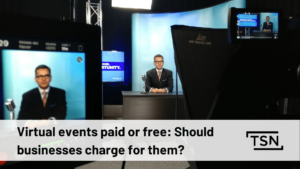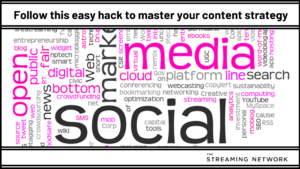The top 10% of the most successful webinar programs are receiving, on average, over 1,000 live viewers. When you consider that one year ago, only the top 1% of webinar programs received this viewership, it’s clear that marketing efforts to build successful webinar programs are increasing. If you’re reading this and starting to fidget because your webinar program has nowhere near this numbers of live viewers-don’t! While a good goal to work towards, the average successful webinar program is receiving 500 registrants with about 200 of them showing up live.
Focusing purely on registrant to live viewer conversion, if you are balancing around the 46% mark, then you are doing well! If you aren’t, then you should still fear not! Based on clients that I have personally worked with here at the Streaming Network over the past decade there are a number of tried and tested truths to the successful ways to promote any virtual event.
Let’s start by saying that the more avenues you use to promote your webinar the better. That being said, statistics are showing that of the avenues used, the largest group of audience members is coming from email campaigns. Second to this is social media and purchasing adds as a form of recruitment. What also needs to be considered is what your promotional content is pointing your potential audience members to. One thing that separates the good from the great is the aggregation of webinar content. Keeping your webinars together in a central location makes it super easy but also convenient for your viewers to opt into other webinars you are going to be hosting or perhaps to previous webinars that are now on demand. If you are tapping into your leads’ sweet spots with the content you are putting out, then leading them to a lovely bouquet of like-webinars neatly tied up in a bow and organized in one place is a gold mine.
In terms of your promotional cycle length, the key message to take away here is that very few people will register anytime longer than 2 weeks out from your webinar date. This seemingly small window can make marketers uncomfortable, so if you need to promote earlier than this, you do not want to do so any more than 4 weeks out, with 2 weeks again being the sweet spot. Where the big numbers hit are the week of your webinar – on average 29% of your registrants will sign up then. Just wait, it gets even cooler – on average a whopping 24% of your registrants will sign up on the day OF your webinar!
Next up? What is the best day of the week to kick off your promotion. Think mid-week: Tuesday/Wednesday/Thursday. Friday’s are the absolute no-no because people do not tend to register over the weekend. I’ve also been informed that the whole idea of getting the invite into their inboxes on a Sunday so it shows up first thing on a Monday is unfortunately also dud. While it might appear as though mid-week invites wouldn’t be ideal because everyone is at the peak of the grind, it actually works out well because this is when we tend to have a good grasp of what our week has in store for us and we can therefore sign up for webinars that suit our schedule.
Audience members continue to favour Wednesdays and Thursdays. If you can’t do either of these days, do not fret because Tuesdays are close behind for an optimal webinar delivery day. Do stay away from Mondays and Fridays however, because you could be losing up to 2/3 of your audience by selecting these days.
Now that we have our ideal days pinned down, what about start time? Across North America, if you are targeting the 9-5 crowds, then 2pm ET is your best bet. This time not only avoids West Coast rush hour, but also occurs after lunch on the East Coast. Starting your webinar at 1pm ET is a close second for the very same reasons. The 12pm ET start time is where we run into some controversy. What’s interesting about 12pm ET is that while it goes against the advantages of the times I previously mentioned, it still shows up in the stats as being the third most attended start time. What’s important to keep in mind here is that the old “lunch and learn” webinar timeslot is fairly entrenched in the corporate world. While the numbers are showing that although this it’s popularity is starting to lose out to the above mentioned later times, there are many organizations (some of them very large) where the 12pm ET lunchtime webinar is deeply entrenched. Although there is nothing wrong with this – if it is not broken, don’t fix it – we must consider that this could be throwing off the numbers slightly.
The last variable I want to cover here is the ideal start time for those who’s jobs are not conducive to viewing webinars during working hours. When the target audience at hand include doctors or pharmacists, the time to start your webinar would be in the evening. It is of utmost importance to respect the fact that while they may not have the ability to take time out of their workday, there is still an interest in seeing your content. If your audience is willing to dedicate time outside of work to access your content, then this is when you need to deliver it. Your evening sweet spot is 6pm ET or 7pm ET. Like with any other communication medium, your success will depend largely on audience interest and them actually being able to engage-the key is understanding your target and serving up a tailored event.






